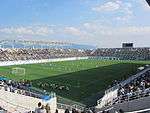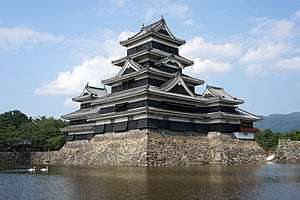Matsumoto, Nagano
| Matsumoto 松本市 | ||
|---|---|---|
| Special city | ||
|
Matsumoto Castle | ||
| ||
 Location of Matsumoto in Nagano Prefecture | ||
 Matsumoto
| ||
| Coordinates: 36°14′N 137°58′E / 36.233°N 137.967°ECoordinates: 36°14′N 137°58′E / 36.233°N 137.967°E | ||
| Country | Japan | |
| Region | Chūbu (Kōshin'etsu) | |
| Prefecture | Nagano Prefecture | |
| Government | ||
| • Mayor | Akira Sugenoya | |
| Area | ||
| • Total | 978.77 km2 (377.91 sq mi) | |
| Population (July 1, 2012) | ||
| • Total | 243,571 | |
| • Density | 250/km2 (640/sq mi) | |
| Time zone | Japan Standard Time (UTC+9) | |
| - Tree | Japanese Red Pine | |
| - Flower | Japanese azalea | |
| Phone number | 0263-34-3000 | |
| Address |
3-7 Marunouchi, Matsumoto-shi, Nagano-ken 390-8620 | |
| Website | City of Matsumoto | |
Matsumoto (松本市 Matsumoto-shi) is a Japanese city in the Chūbu region on the island of Honshu.[1] It is a city located in Nagano Prefecture.[2] Matsumoto is designated as a Special City.[3]
As of July 1, 2012, the city has an estimated population of 243,571 and a population density of 250 persons per km². The total area is 978.77 km².
Outline
The current city of Matsumoto is a merger of the old city of Matsumoto with four villages. Matsumoto officially absorbed those villages without creating a new municipal organization.

Matsumoto is surrounded by mountains and is acclaimed for its beautiful views. Hiking and climbing locations are readily accessible by local bus transportation. Matsumoto has several historic features, such as Matsumoto Castle (松本城 Matsumoto-jō), Kaichi School Museum (Kaichi gakkō), and Temari (traditional Japanese handball).
Matsumoto is attractive to travellers not only because of the traditional culture but also its calm climate and local products. Matsumoto soba is famous for its delicate taste. The world's largest wasabi farm, Daio Wasabi Farm, is located just north of Matsumoto in Azumino.[4] Wasabi can only be grown in extremely clean water so there is much local pride in this product. In addition, Matsumoto is home to the Saito Kinen Festival Matsumoto, held every August by conductor Seiji Ozawa and featuring the Saito Kinen Orchestra; regular guests have included Robert Mann and Mstislav Rostropovich. It is very difficult to get tickets: Many people wait in line two days before tickets go on sale.
Home to several renowned current and former musical instrument factories, such as Matsumoku (closed in 1986) and FujiGen Gakki.
Matsumoto, like many areas in Japan, has many onsen (温泉 or hot springs). It also is host to a number of summer festivals, including the Bon-Bon Festival on the first Saturday of August, which features its signature dance.
Geography
Surrounding municipalities
The city of Matsumoto is surrounded by 14 municipalities.
- Shiojiri
- Azumino
- Yamagata
- Asahi
- Ōmachi
- Chikuhoku
- Ueda
- Nagawa
- Aoki
- Shimosuwa
- Takayama
- Kiso Village
- Kiso Town
The former city of Matsumoto
Since the post merger Matsumoto's (the new city of Matsumoto) area is too big because the city now includes the mountainous areas, the data of the former city (the old city of Matsumoto) is listed on the right.
However, "The city of Matsumoto" is primarily centralized on the old city of Matsumoto because most of the dramas and plays are centralized on Kaichi Gakko (Kaichi School) and Matsumoto Castle.
Since the new city of Matsumoto has absorbed the village of Azumi, the tour guides are calling the area "Matsumoto-Kamikochi Area" instead of "The city of Matsumoto."
The Old Matsumoto City Hall is currently used as the New Matsumoto City Hall. However, the old city of Matsumoto was located within Higashichikuma District, and the district's name came from the former Chikuma Prefecture.
Climate
Matsumoto has a humid subtropical climate (Köppen climate classification Cfa) bordering on a humid continental climate (Köppen Dfa) with hot summers and cold winters. Precipitation is quite high in summer, but the weather is somewhat drier in winter.
| Climate data for Matsumoto, Nagano (1981~2010) | |||||||||||||
|---|---|---|---|---|---|---|---|---|---|---|---|---|---|
| Month | Jan | Feb | Mar | Apr | May | Jun | Jul | Aug | Sep | Oct | Nov | Dec | Year |
| Record high °C (°F) | 18.8 (65.8) |
21.1 (70) |
25.9 (78.6) |
30.9 (87.6) |
32.3 (90.1) |
35.9 (96.6) |
37.9 (100.2) |
38.5 (101.3) |
35.3 (95.5) |
31.8 (89.2) |
25.6 (78.1) |
21.5 (70.7) |
38.5 (101.3) |
| Average high °C (°F) | 5.0 (41) |
6.0 (42.8) |
10.5 (50.9) |
17.8 (64) |
22.9 (73.2) |
26.0 (78.8) |
29.4 (84.9) |
31.1 (88) |
25.7 (78.3) |
19.3 (66.7) |
13.6 (56.5) |
8.0 (46.4) |
17.9 (64.2) |
| Daily mean °C (°F) | −0.4 (31.3) |
0.2 (32.4) |
3.9 (39) |
10.6 (51.1) |
16.0 (60.8) |
19.9 (67.8) |
23.6 (74.5) |
24.7 (76.5) |
20.0 (68) |
13.2 (55.8) |
7.4 (45.3) |
2.3 (36.1) |
11.8 (53.2) |
| Average low °C (°F) | −5.2 (22.6) |
−4.8 (23.4) |
−1.5 (29.3) |
4.1 (39.4) |
9.9 (49.8) |
14.9 (58.8) |
19.2 (66.6) |
20.2 (68.4) |
15.9 (60.6) |
8.4 (47.1) |
2.1 (35.8) |
−2.7 (27.1) |
6.7 (44.1) |
| Record low °C (°F) | −24.8 (−12.6) |
−20.4 (−4.7) |
−17.9 (−0.2) |
−10.1 (13.8) |
−2.7 (27.1) |
2.3 (36.1) |
10.2 (50.4) |
8.0 (46.4) |
3.0 (37.4) |
−3.6 (25.5) |
−8.4 (16.9) |
−19.2 (−2.6) |
−24.8 (−12.6) |
| Average precipitation mm (inches) | 35.9 (1.413) |
43.5 (1.713) |
79.6 (3.134) |
75.3 (2.965) |
100.0 (3.937) |
125.7 (4.949) |
138.4 (5.449) |
92.1 (3.626) |
155.6 (6.126) |
101.9 (4.012) |
54.9 (2.161) |
28.1 (1.106) |
1,031 (40.591) |
| Average snowfall cm (inches) | 28 (11) |
24 (9.4) |
17 (6.7) |
1 (0.4) |
0 (0) |
0 (0) |
0 (0) |
0 (0) |
0 (0) |
0 (0) |
0 (0) |
9 (3.5) |
79 (31) |
| Average precipitation days (≥ 0.5 mm) | 6.0 | 6.6 | 9.6 | 9.1 | 9.7 | 11.1 | 13.1 | 9.7 | 11.2 | 9.0 | 6.3 | 5.4 | 106.8 |
| Average snowy days | 11.2 | 9.8 | 4.9 | 0.4 | 0.0 | 0.0 | 0.0 | 0.0 | 0.0 | 0.0 | 0.1 | 3.7 | 30.1 |
| Mean monthly sunshine hours | 170.7 | 163.5 | 185.0 | 202.1 | 209.0 | 163.6 | 171.3 | 205.4 | 141.8 | 159.9 | 159.2 | 166.0 | 2,097.5 |
| Source #1: Japan Meteorological Agency[5] | |||||||||||||
| Source #2: Japan Meteorological Agency (records)[6] | |||||||||||||
History
Meiji Era
- May 1, 1907 - The town of Matsumoto gained city status alone.
Taishō Era
- February 1, 1925 - The city absorbed the village of Matsumoto (from Higashichikuma District).
Shōwa Era
- April 1, 1943 - The city absorbed the Kanda hamlet of the village of Nakayama (from Higashichikuma District).
- April 1, 1954 - The city absorbed the villages of Nakayama, Shimadachi and Shimauchi (all from Higashichikuma District).
- August 1, 1954 - The city absorbed the villages of Wada, Niimura, Kanbayashi, Sasaga, Yoshikawa, Kotobuki, Okada, Iriyamabe, Satoyamabe and Imai (all from Higashichikuma District).
- April 1, 1960 - The city acquired the Kitauchida ward (excluding the Gakenoyu hamlet from the Minamiuchida ward of the village of Kataoka, from Higashichikuma District) from the city of Shiojiri.
- April 1, 1961 - The city acquired the Gakenoyu hamlet of Minamiuchida ward of the village of Kataoka (from Higashichikuma District) from the city of Shiojiri.
- May 1, 1974 - The city absorbed the village of Hongo (from Higashichikuma District).
- April 1, 1982 - The city acquired parts of Seba hamlet (the hamlet of Kukohigashi) from the city of Shiojiri.
Heisei Era
- Between the days of June 27 and June 28, 1994 - The Matsumoto Incident sarin gas attack occurred.
- November 1, 2000 - Matsumoto became a Special City.
- January 2002 - Matsumoto City Hall gained ISO 14001 rights.
- April 1, 2005 - The city absorbed the villages of Azumi, Azusagawa and Nagawa (all from Minamiazumi District), and the village of Shiga (from Higashichikuma District) to create the new and expanded city of Matsumoto. (Matsumoto officially absorbed all four villages without creating the new municipal organization)
- March 31, 2010 - The city absorbed the town of Hata (from Higashichikuma District).
Sister cities
Within Japan
- Fujisawa (Kanagawa Prefecture)
- Signed on July 29, 1961
- Himeji (Hyōgo Prefecture)
- Signed on November 17, 1966
- Takayama, Gifu (Gifu Prefecture)
- Signed on November 1, 1971
Overseas
- Signed in 1958
- Signed on November 17, 1989
-
 Langfang (Hebei province, China) 河北省廊坊市
Langfang (Hebei province, China) 河北省廊坊市
- Signed on March 21, 1995 as a friendship city
Tourist attractions
- Matsumoto Castle was built more than 400 years ago. It is also called Crow Castle (Karasu Jō) because of its black appearance. The castle is open to tourists and displays many ancient weapons from and inspired by Europe including muskets and rifles.
- Kaichi School is the first junior high school in Japan. The beautiful appearance of Kaichi School is much acclaimed.
Sports
Matsumoto is represented in the J. League of football with its local club, Matsumoto Yamaga FC They play in Alwin Stadium in Kambayashi.
Food
A variety of food can be enjoyed in Matsumoto due to its relatively large size in comparison to the surrounding towns. There is a famous yakitori in Matsumoto near Matsumoto Station where the main cook sprinkles salt onto the meat and catching some in his hat.
Education
The city has a North Korean school, Nagano Korean Elementary and Junior High School (長野朝鮮初中級学校).
Gallery
 Four Pillars Shrine
Four Pillars Shrine Kaichi School
Kaichi School Garden in former Matsumoto High School (present day of Shinshu University)
Garden in former Matsumoto High School (present day of Shinshu University) Matsumoto Alwin football stadium
Matsumoto Alwin football stadium View of downtown Matsumoto from Mount Koubou
View of downtown Matsumoto from Mount Koubou Kappa Bridge in Kamikochi
Kappa Bridge in Kamikochi Matsumoto City Museum of Art
Matsumoto City Museum of Art Matsumoto Ukiyoe Museum
Matsumoto Ukiyoe Museum Azusa River in Kamikochi
Azusa River in Kamikochi Taisho Pond in Kamikochi
Taisho Pond in Kamikochi
References
- ↑ Nussbaum, Louis-Frédéric. (2005). "Maatsumoto" in Japan Encyclopedia, p. 618; "Chūbu" at p. 126.
- ↑ Japan National Tourism Organization (JNTO), "Matsumoto/Shiojiri Area"; retrieved 2012-2-11.
- ↑ Jacobs, A.J. "Japan's Evolving Nested Municipal Hierarchy: The Race for Local Power in the 2000s," Urban Studies Research, (2011); Table 3; retrieved 20132-2-11.
- ↑ http://welcome.city.matsumoto.nagano.jp/contents03+index.id+15.htm
- ↑ "平年値(年・月ごとの値)". Japan Meteorological Agency. Retrieved 2010-03-06.
- ↑ "観測史上1~10位の値(年間を通じての値)". Japan Meteorological Agency. Retrieved 2011-11-18.
External links
![]() Media related to Matsumoto, Nagano at Wikimedia Commons
Media related to Matsumoto, Nagano at Wikimedia Commons
| Wikivoyage has a travel guide for Matsumoto. |
- Matsumoto City official website (Japanese) (English)
- Matsumoto City official tourist information website (Japanese) (English) (Chinese) (Korean) (Russian)

